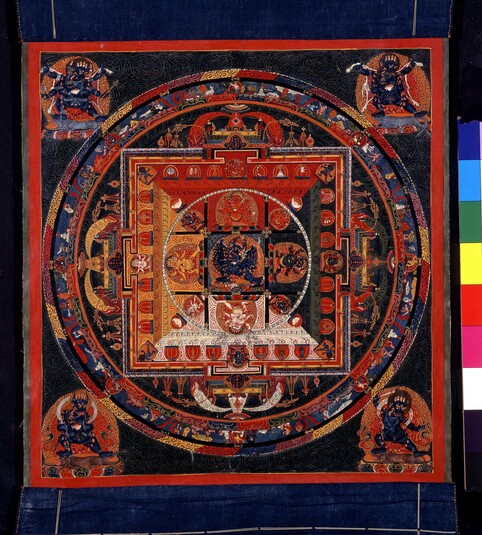
Item: Mandala of Vajrabhairava (Buddhist Deity) - Solitary (Ekavira)
| Origin Location | Tibet |
|---|---|
| Date Range | 1400 - 1499 |
| Lineages | Sakya, Ngor (Sakya) and Buddhist |
| Size | 86.36x50.80cm (34x20in) |
| Material | Ground Mineral Pigment on Cotton |
| Collection | Asian Art Museum of San Francisco |
| Catalogue # | B63D5 |
Classification: Deity
Appearance: Animal-Feature
Gender: Male
Vajrabhairava Mandala according to the Shri Vajrabhairava Nama Tantra [Toh 468]. This painting is likely from a set of paintings depicting the principal meditational deities of the Sakya Tradition.
Video: Vajrabhairava Mandala HAR #69414
Within the center of the two dimensional circular diagram (mandala) representing the top view of a three dimensional celestial palace and surroundings is the deity Vajrabhairava, dark blue in colour, with nine faces, thirty-four hands holding a variety of objects, and sixteen legs trampling on various animals, birds and gods. The first pair of hands hold a curved knife and skullcup. He is adorned with bone ornaments and stands atop a lotus within the flames of pristine awareness.
Surrounding the central figure are eight pairs of retinue Bhairavas of various colour, each with three faces and six hands. At the four 'T' shaped doors stand four guardian figures.
The floor of the celestial palace is divided into four colours ornately patterned with floral designs: red, blue, white and yellow. The outer red, white and blue pattern forming a square outermost enclosure represent the stylized decorative facade on the four sides of the palace roof. The elaborate lintels above each of the four doors are constructed of tiered multi-coloured steps topped with a Dharma wheel, two reclining deer and gold spires; with a silk canopy above.
Surrounding the palace is a circle of multi-coloured, rectangular shaped, lotus petals (Skt.: padmavali) representing the enormous lotus upon which the entire palace structure rests. The outer circle, divided into eight sections, containing small figures and objects is the ring of the eight great charnel grounds filled with corpses, fires, chaityas (stupas), yogis, nagas, and wrathful worldly deities. All of that is surrounded by a circle of gold vajras (Skt.: vajravali) on a black background and finally surrounded by a ring of multi-coloured fire (Skt.: jvalavali) of pristine awareness completely enveloping the Vajrabhairava Mandala.
At the top left is Krishna Yamari, wrathful, blue in colour, with three faces and six hands, standing atop a buffalo. On the right is one faced and four armed Krishna Yamari. At the bottom left is Heruka Vajrabhairava with one face and two hands. On the right side is Yama Dharmaraja the special protector for the Vajrabhairava Cycle of practices.
As a complex meditational deity Vajrabhairava, sometimes referred to as Yamantaka, belongs to the Bhairava and Yamari class of tantras and specifically arises from the Vajrabhairava Root Tantra (Tibetan: jig je tsa gyu). All of those belong to the method (father) classification of Anuttaryoga Tantra. The practice of Bhairava is common to the three new (sarma) Schools of Tibetan Buddhism beginning in the 11th century: Sakya, Kagyu and Gelugpa. Among the Sakya it is counted as one of the four main tantric deities along with Hevajra, Guhyasamaja and Chakrasamvara (Tibetan: gyu de shi). Amongst the various Kagyu Schools the Drigungpa have been strong upholders of the practice. There are numerous forms and styles of practice from the very complex with numerous deities to the very concise with a single Heruka form. From the many lineages to enter Tibet the main ones were those of Jowo Atisha, Rwa Lotsawa and Mal Lotsawa.
Mal Lineage: the lord of Refuge Vajradhara, Arya Manjushri, Acharya Buddha Jnana, Dipamkara Zangpo, Brahmin Shridhara, the pandita and mahasiddha Naropa, Minyam Dorje Khol, the Nepali of Yerang Bharo Chagdum, Mal Lotsawa Lodro Dragpa, Sachen Kunga Nyingpo (1092-1158), etc.
Jeff Watt 5-2009
Buddhist Deity: Vajrabhairava Main Page
Collection of Asian Art Museum of San Francisco
Collection of Asian Art Museum of San Francisco (Masterworks)
Mandala: Sakya Masterworks
Bibliography: Videos - Exhibition Catalogue Reviews
Collection of Asian Art Museum of San Francisco (Sakya Selection Masterworks)
Buddhist Deity: Vajrabhairava, Mandalas
Subject: Ngor Masterworks
Buddhist Deity: Vajrabhairava Seventeen Deity Configuration
Buddhist Deity: Vajrabhairava Art History
Buddhist Deity: Vajrabhairava (Stacked Faces, Painting)
Exhibition: Awaken (Rubin Museum)
Collection of Asian Art Museum of San Francisco (Curator's Selection, Painting Masterworks)
Buddhist Deity: Vajrabhairava (Early Works, Painting & Textile)
Collection Index: Museums
Buddhist Deity: Vajrabhairava (Mandala Masterworks)
